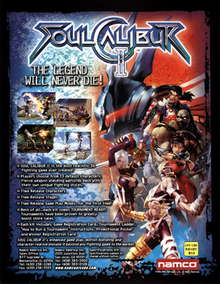| Soulcalibur II | |
|---|---|
 | |
| Developer(s) | Project Soul |
| Publisher(s) |
|
| Director(s) | Jin Okubo Yoshitaka Tezuka |
| Producer(s) | Hiroaki Yotoriyama |
| Programmer(s) | Shinobu Nimura |
| Artist(s) | Takuji Kawano |
| Writer(s) | Yoshihiro Nakagawa |
| Composer(s) | Junichi Nakatsuru Yoshihito Yano Asuka Sakai Rio Hamamoto |
| Series | Soulcalibur |
| Platform(s) | Arcade, GameCube, PlayStation 2, Xbox, PlayStation 3, Xbox 360 |
| Release | |
| Genre(s) | Fighting |
| Mode(s) | Single-player, multiplayer |
| Arcade system | Namco System 246[8] |
Soulcalibur II[9] is a 2002 arcade fighting video game developed by Project Soul and published by Namco. It is the third installment in the Soulcalibur series of weapon-based fighting games as the sequel to Soulcalibur (1998). Originally intended to be released on Sega's NAOMI arcade board,[10] the game was built on the Namco System 246 board before being ported to the PlayStation 2, GameCube, and Xbox home consoles in 2003.
The game's plot revolves around the legendary weapon Soul Edge having been shattered into pieces, with different characters seeking to collect all the pieces to gain possession of the complete weapon or to destroy it once and for all. Compared to Soulcalibur, Soulcalibur II had improvements in graphics and the game system and introduced several new and guest characters.
The game was a critical and commercial success, with the introduction of guest characters to the series, particularly Link on the GameCube version, being acclaimed by critics and audiences alike, and considered to be one of the greatest fighting games made. A high-definition port, titled SoulCalibur II HD Online, based on the PlayStation 2 version, was released for the PlayStation 3 and Xbox 360 in 2013. It received a sequel, Soulcalibur III (2005).
- ^ "Soul Calibur 2 New Version". IGN. September 12, 2002. Retrieved May 12, 2024.
- ^ "Soul Calibur II Delayed". IGN. July 3, 2002. Retrieved May 12, 2024.
- ^ "Soul Calibur II Sales Strong". IGN. September 30, 2003. Retrieved May 12, 2024.
- ^ a b c Romano, Sal (October 31, 2013). "Soulcalibur II HD Online release date set". Gematsu. Retrieved October 31, 2013.
- ^ "Soul Calibur II HD Online Gets Japanese Release Date". Avoiding The Puddle. January 27, 2014. Retrieved September 25, 2019.
- ^ Calvert, Justin (January 16, 2003). "EA to publish Soul Calibur II in Europe". GameSpot.
- ^ Calvert, Justin (July 11, 2003). "European Soul Calibur II release announced". GameSpot.
- ^ "Soul Calibur 2 Hits Arcades In June". IGN. March 21, 2002. Retrieved September 26, 2019.
- ^ ソウルキャリバーII, Sōrukyaribā Tsū
- ^ IGN Staff (January 12, 2000). "Soul Calibur 2 Confirmed For Naomi?".